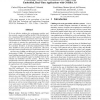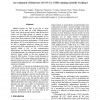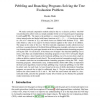1421 search results - page 33 / 285 » The First and Second Max-SAT Evaluations |
SPAA
2010
ACM
14 years 12 days ago
2010
ACM
Transactional Memory (TM) is a promising technique that simplifies parallel programming for shared-memory applications. To date, most TM systems have been designed to efficientl...
RTAS
2000
IEEE
13 years 12 months ago
2000
IEEE
To be an effective platform for performance-sensitive realtime systems, commercial-off-the-shelf (COTS) distributed object computing (DOC) middleware must support application qual...
DSD
2009
IEEE
13 years 11 months ago
2009
IEEE
Modern systems are able to put two or more processors on the same die (Chip Multiprocessors, CMP), each with its private caches, while the last level caches can be either private ...
ACL
2000
13 years 9 months ago
2000
The definitions of the basic concepts, rules, and constraints of centering theory involve underspecified notions such as `previous utterance', `realization', and `rankin...
CORR
2010
Springer
13 years 7 months ago
2010
Springer
We study restricted computation models related to the tree evaluation problem. The TEP was introduced in earlier work as a simple candidate for the (very) long term goal of separa...



